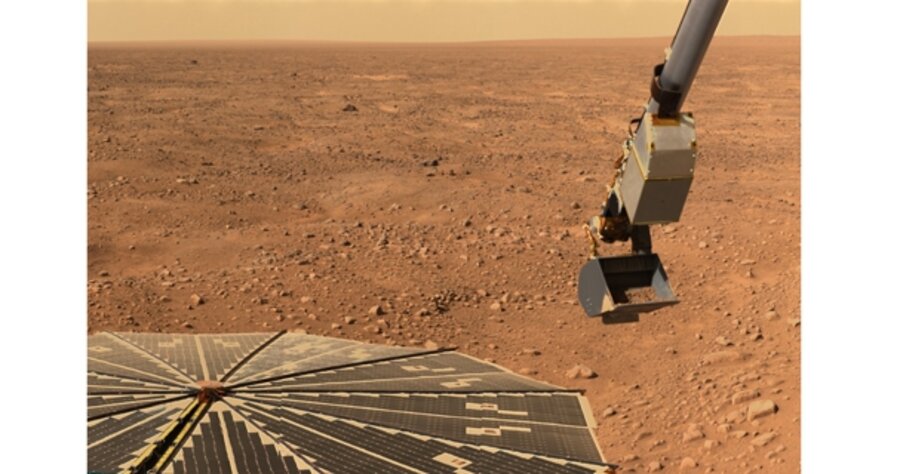An unexpected find on Mars
Loading...
With each scoop of soil the Phoenix Mars Lander unearths, Martian soils are looking more and more earthlike in mineral and chemical composition.
Scientists announced Tuesday that the lander has detected perchlorate – salts built on a foundation of chlorine and oxygen – in soil samples it has scooped from the red planet’s surface. On Earth, perchlorates occur naturally, in addition to their production for use in solid-rocket fuel, fireworks, and at one time in the US as treatment for thyroid conditions.
The announcement comes roughly a month after the Phoenix Mars Lander team detected traces of other substances found on Earth: magnesium, sodium, potassium, fluorides, and chloride in soil samples, as well as potential nutrients.
But before Tuesday’s announcement, word had leaked out about the detection of perchlorate on Mars, triggering a round of media speculation about how that might change the calculus for the possibility of life on the red planet. The upshot? The data so far buttress neither the notion that perchlorate’s presence makes a better habitat for life nor the opposite suggestion that it would rule out favorable conditions, scientists said Tuesday.
For humans, industrial and even naturally occurring perchlorate has become a serious pollution and public-health issue. But in places such as the Atacama Desert in Chile – often used as a stand-in for the Martian environment – scientists have found soil microbes that either tolerate perchlorate in soils or thrive on it. In the US, scientists with the US Geological Survey reported last year the presence of substantial deposits of naturally occurring perchlorate in several locations throughout the Southwest, typically just below the plant root zone.
Evidence for perchlorate on Mars “caught me by surprise,” says Peter Smith, the mission’s lead investigator. Nobody mentioned the possibility that the team would find perchlorate in Martian soils, he continued. “I had to go straight back to the textbooks to find out what this material is.”
Despite Tuesday’s public announcement, the team is treating the evidence with caution. Among other tasks, scientists are trying to ensure that the perchlorate traces they see in their samples don’t represent contamination from fuel in the Delta II rocket that lofted the lander.
Moreover, readings from instruments are not as consistent as they might be. While the team got perchlorate readings in one instrument from two separate soil samples, a second instrument did not clearly identify the compound in samples it analyzed.
Ordinarily, researchers would have tried to cross every “t” and dot every “i” before they went public with the results. But heading into last weekend, tantalizing leaks about a pending “big” announcement dealing with the prospects for Martian habitats had triggered a flurry of reports in the traditional media and the blogosphere. The leaks came after the team reported that direct measurements of the ice just beneath the surface at the landing site is indeed water ice. At the least, one well-trafficked blogger wrote, “the new data appears [sic] to indicate the ‘potential for life’ more conclusively than ... the water results.” Other news reports suggested quite the opposite: that the new data would sound the death knell for favorable habitats, at least around the landing site.
So far, the lander has found no evidence of organic molecules at the site. Perchlorates could explain that, because they are oxidants and tend to break down organic molecules.
Yet members of the science team also note that some earthly bacteria dine on perchlorates.
At this stage, the team doesn’t have enough information from the lander’s instruments to determine the concentration or type of perchlorate they appear to have found.
“This shows how interested the public is in Mars and the concept of life on Mars,” says Bruce Betts, director of projects for the Planetary Society in Pasadena, Calif.
In Chile’s Atacama Desert, perchlorates literally fall from the sky, notes Richard Quinn, a member of the Phoenix Mars Lander science team. Through a complex set of chemical reactions energized by the sun and carried out on airborne dust grains and aerosols, chlorine from sea salt and volcanic eruptions combines with oxygen to form the backbone for perchlorate salts.
On Mars, which doesn’t lack for sunlight and airborne dust, volcanic activity would be the likely source for chlorine, Dr. Quinn adds.
As for habitats, future missions may have to dig deeper in other locations. Scientists studying the life in the Atacama Desert have found only low numbers of culturable bacteria and no recoverable DNA in the top four inches of soil in the desert’s most arid region. But at least two teams have reported large numbers of bacteria at depths of eight to 12 inches.





